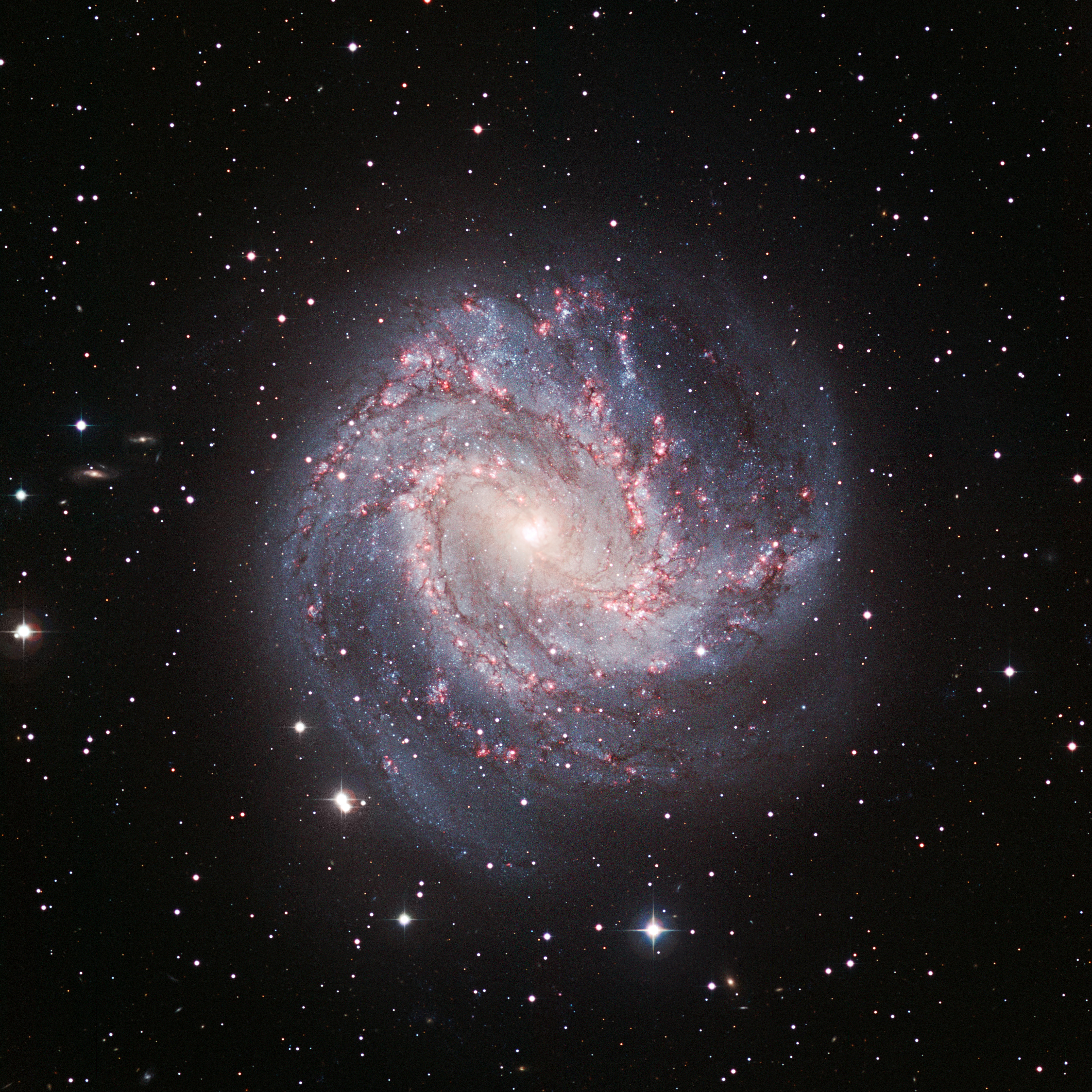|
IC 342
IC 342 (also known as Caldwell 5) is an intermediate spiral galaxy in the constellation Camelopardalis, located relatively close to the Milky Way. Despite its size and actual brightness, its location behind dusty areas near the galactic equator makes it difficult to observe, leading to the nickname "The Hidden Galaxy", though it can readily be detected even with binoculars. If the galaxy were not obscured, it would be visible by naked eye. The dust makes it difficult to determine its precise distance; modern estimates range from about 7 mega light-years (Mly) to about 11 Mly. The galaxy was discovered by William Frederick Denning in 1892. It is one of the brightest in the IC 342/Maffei Group, one of the closest galaxy groups to the Local Group. Edwin Hubble first thought it to be in the Local Group, but it was later determined not to be a member. In 1935, Harlow Shapley found that it was wider than the full moon, and by angular size the third-largest spiral galaxy then known, smal ... [...More Info...] [...Related Items...] OR: [Wikipedia] [Google] [Baidu] |
William Frederick Denning
William Frederick Denning (25 November 1848 – 9 June 1931) was a British amateur astronomer who achieved considerable success without formal scientific training. He is known for his catalogues of meteor radiants, observations of Jupiter's red spot, and for the discovery of five comets. Outside astronomy, as a young man, Denning showed prowess at cricket to the extent W G Grace invited him to play for Gloucestershire. However Denning’s retiring nature made him decline the offer. Career Denning devoted a great deal of time to searching for comets, and discovered five of them, including the periodic comet 72P/Denning–Fujikawa and the lost comet D/1894 F1. The latter was the last comet discovered on British soil until the discoveries of George Alcock. Denning also studied meteors and novae, discovering Nova Cygni 1920 (V476 Cyg). From 1869 Denning held the combined post of secretary and treasurer of the short-lived Observing Astronomical Society. Denning was elected to the ... [...More Info...] [...Related Items...] OR: [Wikipedia] [Google] [Baidu] |
Intermediate Spiral Galaxies
An intermediate spiral galaxy is a galaxy that is in between the classifications of a barred spiral galaxy and an unbarred spiral galaxy. It is designated as SAB in the galaxy morphological classification system devised by Gerard de Vaucouleurs. Subtypes are labeled as SAB0, SABa, SABb, or SABc, following a sequence analogous to the Hubble sequence for barred and unbarred spirals. The subtype (0, a, b, or c) is based on the relative prominence of the central bulge and how tightly wound the spiral arms Spiral galaxies form a class of galaxy originally described by Edwin Hubble in his 1936 work ''The Realm of the Nebulae'' [...More Info...] [...Related Items...] OR: [Wikipedia] [Google] [Baidu] |
Astronomical Objects Discovered In 1892
Astronomy () is a natural science that studies celestial objects and phenomena. It uses mathematics, physics, and chemistry in order to explain their origin and evolution. Objects of interest include planets, moons, stars, nebulae, galaxies, and comets. Relevant phenomena include supernova explosions, gamma ray bursts, quasars, blazars, pulsars, and cosmic microwave background radiation. More generally, astronomy studies everything that originates beyond Earth's atmosphere. Cosmology is a branch of astronomy that studies the universe as a whole. Astronomy is one of the oldest natural sciences. The early civilizations in recorded history made methodical observations of the night sky. These include the Babylonians, Greeks, Indians, Egyptians, Chinese, Maya, and many ancient indigenous peoples of the Americas. In the past, astronomy included disciplines as diverse as astrometry, celestial navigation, observational astronomy, and the making of calendars. Nowadays, p ... [...More Info...] [...Related Items...] OR: [Wikipedia] [Google] [Baidu] |
NGC 6946
NGC 6946, sometimes referred to as the Fireworks Galaxy, is a face-on intermediate spiral galaxy with a small bright nucleus, whose location in the sky straddles the boundary between the northern constellations of Cepheus and Cygnus. Its distance from Earth is about 25.2 million light-years or 7.72 megaparsecs, similar to the distance of M101 (NGC 5457) in the constellation Ursa Major. Both were once considered to be part of the Local Group, but are now known to be among the dozen bright spiral galaxies near the Milky Way but beyond the confines of the Local Group. NGC 6946 lies within the Virgo Supercluster. The galaxy was discovered by William Herschel on 9 September 1798. Based on an estimation by the Third Reference Catalogue of Bright Galaxies (RC3) in 1991, the galaxy has a D25 B-band isophotal diameter of . It is heavily obscured by interstellar matter due to its location close to the galactic plane of the Milky Way. Due to its prodigious star formation it has been c ... [...More Info...] [...Related Items...] OR: [Wikipedia] [Google] [Baidu] |
Dwarf Spheroidal Galaxy
A dwarf spheroidal galaxy (dSph) is a term in astronomy applied to small, low-luminosity galaxies with very little dust and an older stellar population. They are found in the Local Group as companions to the Milky Way and to systems that are companions to the Andromeda Galaxy (M31). While similar to dwarf elliptical galaxies in appearance and properties such as little to no gas or dust or recent star formation, they are approximately spheroidal in shape and generally have lower luminosity. Discovery Despite the radii of dSphs being much larger than those of globular clusters, they are much more difficult to find due to their low luminosities and surface brightnesses. Dwarf spheroidal galaxies have a large range of luminosities, and known dwarf spheroidal galaxies span several orders of magnitude of luminosity. Their luminosities are so low that Ursa Minor, Carina, and Draco, the known dwarf spheroidal galaxies with the lowest luminosities, have mass-to-light ratios (M/L) greate ... [...More Info...] [...Related Items...] OR: [Wikipedia] [Google] [Baidu] |
Triangulum Galaxy
The Triangulum Galaxy is a spiral galaxy 2.73 million light-years (ly) from Earth in the constellation Triangulum. It is catalogued as Messier 33 or NGC (''New General Catalogue)'' 598. With the D25 isophotal diameter of , the Triangulum Galaxy is the third-largest member of the Local Group of galaxies, behind the Andromeda Galaxy and the Milky Way. The galaxy is the smallest spiral galaxy in the Local Group (although the smaller Large and Small Magellanic Clouds may have been spirals before their encounters with the Milky Way), and is believed to be a satellite of the Andromeda Galaxy or on its rebound into the latter due to their interactions, velocities, and proximity to one another in the night sky. It also has an H II nucleus. Etymology The galaxy gets its name from the constellation Triangulum, where it can be spotted. It is sometimes informally referred to as the "Pinwheel Galaxy" by some astronomy references, in some computerized telescope software, and in some pub ... [...More Info...] [...Related Items...] OR: [Wikipedia] [Google] [Baidu] |
Andromeda Galaxy
The Andromeda Galaxy (IPA: ), also known as Messier 31, M31, or NGC 224 and originally the Andromeda Nebula, is a barred spiral galaxy with the diameter of about approximately from Earth and the nearest large galaxy to the Milky Way. The galaxy's name stems from the area of Earth's sky in which it appears, the constellation of Andromeda, which itself is named after the princess who was the wife of Perseus in Greek mythology. The virial mass of the Andromeda Galaxy is of the same order of magnitude as that of the Milky Way, at . The mass of either galaxy is difficult to estimate with any accuracy, but it was long thought that the Andromeda Galaxy is more massive than the Milky Way by a margin of some 25% to 50%. This has been called into question by a 2018 study that cited a lower estimate on the mass of the Andromeda Galaxy, combined with preliminary reports on a 2019 study estimating a higher mass of the Milky Way. The Andromeda Galaxy has a diameter of about , making it the ... [...More Info...] [...Related Items...] OR: [Wikipedia] [Google] [Baidu] |
Full Moon
The full moon is the lunar phase when the Moon appears fully illuminated from Earth's perspective. This occurs when Earth is located between the Sun and the Moon (when the ecliptic coordinate system, ecliptic longitudes of the Sun and Moon opposition (astronomy), differ by 180°). This means that the lunar hemisphere facing Earth—the near side of the Moon, near side—is completely sunlit and appears as an approximately circular disk. The full moon occurs roughly once a month. The time interval between a full moon and the next repetition of the same phase, a Lunar month#Synodic month, synodic month, averages about 29.53 days. Therefore, in those lunar calendars in which each month begins on the day of the new moon, the full moon falls on either the 14th or 15th day of the lunar month. Because a calendar month consists of a Natural number, whole number of days, a month in a lunar calendar may be either 29 or 30 days long. Characteristics A full moon is often thought of as an ... [...More Info...] [...Related Items...] OR: [Wikipedia] [Google] [Baidu] |
Harlow Shapley
Harlow Shapley (November 2, 1885 – October 20, 1972) was an American scientist, head of the Harvard College Observatory (1921–1952), and political activist during the latter New Deal and Fair Deal. Shapley used Cepheid variable stars to estimate the size of the Milky Way Galaxy and the Sun's position within it by using parallax.Bart J. Bok. Harlow Shapely 1885–1972 A Biographical Memoir. National Academy of Sciences In 1953 he proposed his "liquid water belt" theory, now known as the concept of a habitable zone.Richard J. Hugget, ''uGeoecology: an evolutionary approach''. p. 10 Background Shapley was born on a farm five miles outside Nashville, Missouri, to Willis and Sarah (née Stowell) Shapley. He went to school in Jasper, Missouri, but not beyond elementary school. He worked as a journalist after studying at home and covering crime stories as a newspaper reporter for the ''Daily Sun'' in Chanute, Kansas, and intermittently for the ''Times'' of Joplin, Missouri. In Chanu ... [...More Info...] [...Related Items...] OR: [Wikipedia] [Google] [Baidu] |
Edwin Hubble
Edwin Powell Hubble (November 20, 1889 – September 28, 1953) was an Americans, American astronomer. He played a crucial role in establishing the fields of extragalactic astronomy and observational cosmology. Hubble proved that many objects previously thought to be clouds of dust and gas and classified as "nebulae" were actually Galaxy, galaxies beyond the Milky Way. He used the strong direct period-luminosity relation, relationship between a classical Cepheid variable's luminosity and periodic function, pulsation period (discovered in 1908 by Henrietta Swan Leavitt) for scaling cosmic distance ladder, galactic and extragalactic distances. Hubble provided evidence that the recessional velocity of a galaxy increases with its distance from the Earth, a property now known as "Hubble's law", although it had been proposed two years earlier by Georges Lemaître. The Hubble law implies that the universe is expanding. A decade before, the American astronomer Vesto Slipher had provid ... [...More Info...] [...Related Items...] OR: [Wikipedia] [Google] [Baidu] |








